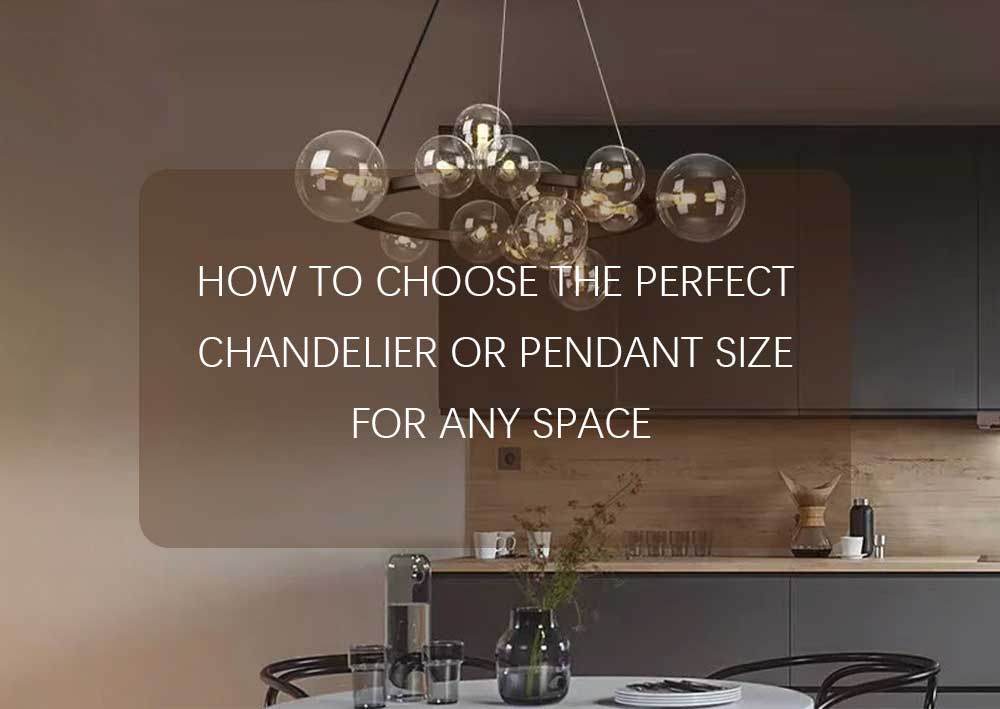1. Consider the Room Size
The overall size of the room is the first factor to consider when choosing a chandelier or pendant. A fixture that's too large can overwhelm the space, while one that's too small might not provide adequate lighting or visual impact.
Formula: A simple guideline is to add the length and width of the room (in feet) and convert that number to inches. For example, a room that's 12 feet by 14 feet would ideally have a chandelier that is about 26 inches in diameter.

How to determine the chandelier’s height
Measure the ceiling height of your space in feet, then multiply that number by 2.5. This will give you the ideal chandelier height in inches.
Example:
Room height: 11 feet
11 × 2.5 = 27.5 → The chandelier should be about 27.5 inches tall.
This rule works especially well for pendant-style chandeliers.

3. Hanging Height Guidelines
For open spaces, the bottom of the chandelier should be at least 7.5 feet above the floor.
For dining rooms or kitchen islands, the chandelier should hang 30 to 36 inches above the table surface.
2. Determine the Function of the Fixture
Consider what purpose the chandelier or pendant will serve in the room. Is it the primary source of light, or is it meant to be a decorative piece that adds ambiance?
Primary Lighting: If the fixture is the main source of light, ensure it’s large enough to illuminate the entire space effectively. Consider using multiple pendants if the area is expansive.
Accent Lighting: For decorative purposes, you can opt for a more visually striking piece that complements the room’s design, even if it's slightly smaller.
3. Dining Room: Over the Table
In dining rooms, the chandelier or pendant typically hangs over the dining table. The size of the table should guide your choice.
Width: The chandelier should be about 1/2 to 2/3 the width of the table. This proportion ensures balance and avoids overcrowding the space.
Height: The fixture should hang 30 to 34 inches above the table for an 8-foot ceiling. Add 3 inches for every additional foot of ceiling height.

4. Living Room: Central Focus
In living rooms, the chandelier or pendant often serves as a central focal point.
Room Height: If your living room has a high ceiling, you can opt for a larger fixture or even a multi-tiered chandelier. For lower ceilings, choose a flush or semi-flush mount to avoid crowding the space.
Visual Weight: Consider the visual weight of the fixture, not just its actual size. A design with intricate details might appear larger than it is, so scale down if the design is particularly elaborate.
5. Entryway: First Impressions Matter
The entryway is where you make the first impression, and the chandelier or pendant should reflect that.
Size: In a two-story foyer, the fixture should fill the vertical space without overwhelming it. A rule of thumb is to ensure that the bottom of the chandelier hangs no lower than the second floor. For a single-story entryway, follow the room size formula and ensure it complements the surrounding decor.
Clearance: Ensure there’s at least 7 feet of clearance from the floor to the bottom of the chandelier to avoid it feeling intrusive.
6. Bedroom: Create a Cozy Ambiance
In bedrooms, a chandelier or pendant adds a touch of elegance and can serve as a statement piece.
Over the Bed: If placing the fixture over the bed, ensure it’s centered and consider a softer light to create a relaxing atmosphere. The fixture should be 20-30 inches above the bed for a cozy, inviting look.
Room Size: For a smaller bedroom, opt for a more delicate design that doesn’t overpower the space. Larger bedrooms can accommodate more substantial fixtures, but balance is key.
7. Kitchen: Functional and Stylish
Kitchens often benefit from multiple pendant lights, especially over islands or counters.
Spacing: If using multiple pendants, space them evenly, typically 24 to 30 inches apart, depending on the size of the pendants. This ensures adequate light distribution.
Height: Hang pendants 30 to 36 inches above the counter to provide ample task lighting without obstructing the view.
Conclusion
Choosing the right size chandelier or pendant involves a balance of function, proportion, and aesthetics. By considering the room's dimensions, the fixture's intended purpose, and the surrounding decor, you can select a lighting piece that not only illuminates but also enhances the beauty and harmony of your space.
Two-Story Foyer with Staircase
For grand entryways or staircases, the chandelier’s bottom should still hang at least 7.5 feet from the floor, but you’ll also want to think about how it looks from the second level.
Two common approaches are:
Eye-level placement: Hang the chandelier so that the top aligns with eye level when viewed from the second floor.
Architectural alignment: Position the chandelier with prominent architectural features (such as centered in a tall window) to maximize its visual impact from both inside and outside.

Long Hallways
For hallways, multiply the width of the hallway (in feet) by 2.5 to determine the chandelier diameter in inches.
Example:
Hallway width: 8 feet
8 × 2.5 = 20 → The chandelier should be about 20 inches wide.
Tips for hallways:
Center the chandelier in the middle of the hallway.
Space fixtures 8–10 feet apart.


